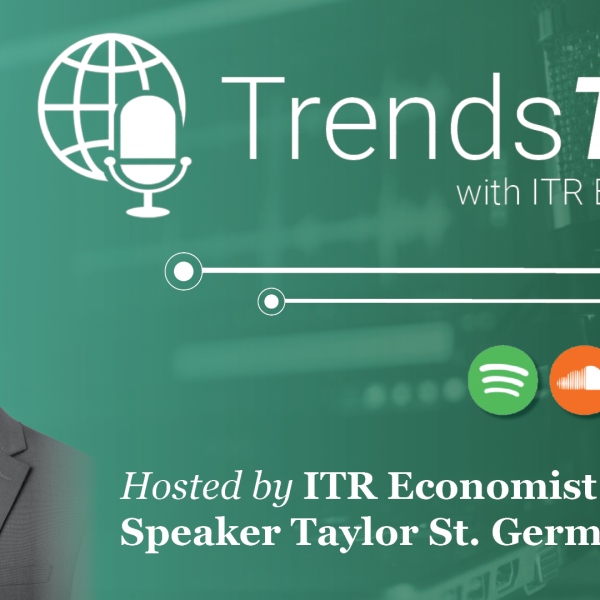- Mon - Fri: 8:30 - 5:00
- +1-603-796-2500
- ITR@itreconomics.com
July 14, 2023
- Home
- portfolio
- TrendsTalk
- July 14, 2023
with Taylor St. Germain
CONSUMER RESILIENCY
What are consumer trends telling us about our 2024 GDP outlook, and how will those trends impact your business planning? Catch our newest TrendsTalk episode with ITR Economist Taylor St. Germain to learn more!
The below transcript is a literal translation of the podcast audio that has been machine generated by Rev.
Hi everyone. My name’s Taylor St. Germain. I’m an economist with ITR Economics, and welcome to this episode of Trends Talk.
Today I want to discuss the consumer, the resilience of the consumer and maybe some potential strains on the consumer as we go into late 2023 and into 2024. Most importantly, I’d like to discuss what these trends mean for our 2024 GDP outlook. Let me remind you that in 2024, we do have a couple quarters of mild contraction for US GDP. However, it’s a very mild recession compared to previous recessions that we’ve been through as a US economy.
One of the reasons that we see this recession being mild is because of the strength in resiliency in the consumer. Now, that’s not to say that there isn’t some pressure on the consumer right now. However, the consumer is continuing to show that they’re very resilient. And given that consumer spending is about 66% of GDP, about two thirds percent of GDP, it’s a really important to understand how the consumer is faring.
Today, I wanted to share two groups of metrics with you that highlights the consumer’s strength. The first being household debt per capita and credit card debt per household, both as a percentage of median annual earnings. And then I’ll share with you some notes about some delinquency rates, particularly auto, credit card and residential delinquency rates. But first, let’s start with household debt per capita and credit card debt per household as a percentage of median annual earnings.
Currently, household debt per capita as a percentage of median annual earnings is 111.6%. Now, some of you might hear 111% and might seem shocking to you. However, historical context here is important. Our household debt per capita has essentially been at that level for all the way back until 2012. So we haven’t seen a significant rise in that level. We haven’t seen a significant decline in that level. But let me remind you, between 2010 and 2019, we had this record setting decade of growth all while household debt per capita was 111%. Not to mention when we look back to the ’08, ’09 financial crisis, household debt per capita was north of 145%. So overall, from a overall household debt per capita perspective the consumer hasn’t really budged over the last decade, and that’s good news.
When we look at credit card debt per household, again as a percentage of median annual earnings, that’s at 13.3%. That’s lower than where we were between 2010 and 2019 in terms of that record setting GDP economy that we had throughout that time. So that’s good news. Consumers are better positioned from a credit card debt perspective now than even where they were throughout this last decade. And again, to give you the ’08, ’09 peak number, that was about 21%. So we’re well below the peak in 2009 in terms of that overall credit card debt per household. So we have low levels of credit card debt right now compared to history and our household debt really hasn’t changed all that much. Good news in terms of this 2024 GDP outlook that we have remaining mild at this point.
Now the next set is delinquency rates. Auto loan delinquencies, they’ve risen a little bit, but only about 0.2% off of a five-year low. So we’re paying our auto loans. Credit card delinquency is currently at 2.53%, so a little bit different than that previous credit card metric. I’m not looking at overall credit card debt, I’m looking at credit card delinquency rates. And so that delinquency rate’s 2.53%. The pre-COVID 10 year average was 2.76%. Low numbers in this case are good since we’re looking at delinquency rates and we’re below the pre-COVID 10 year average, we’re paying our auto loans, we’re paying our credit cards. And then finally, my favorite, residential delinquency, it’s currently at 1.74%. That’s the lowest delinquency in 16 and a half years. We’re paying our mortgages as well.
And a lot of clients say, “Hey, is 2024 similar to ’08, ’09, do we expect that same level of downturn?” And the answer is it’s not even close. 2024 is much more mild in terms of our GDP outlook. Looking at something like residential delinquency, which is incredibly low, and which was actually the problem during 2008, 2009, we don’t see those concerns. So overall, yes, there’s some pressure on the consumer with the Federal Reserve’s battle with inflation and higher interest rates, but the consumer is proving to be resilient. We’re paying our loans, we have low levels of debt, and that’s good news for a 2024 recession outlook remaining mild.
I hope that was helpful. We’ll continue to update you on the consumer. Follow us on LinkedIn, head to our website, follow the Trends Report. We’re constantly updating these consumer metrics and sharing with you how we feel about the strength of the consumer here in the US. Thanks so much for joining me on this episode of Trends Talk, and I’ll see you on the next one.





